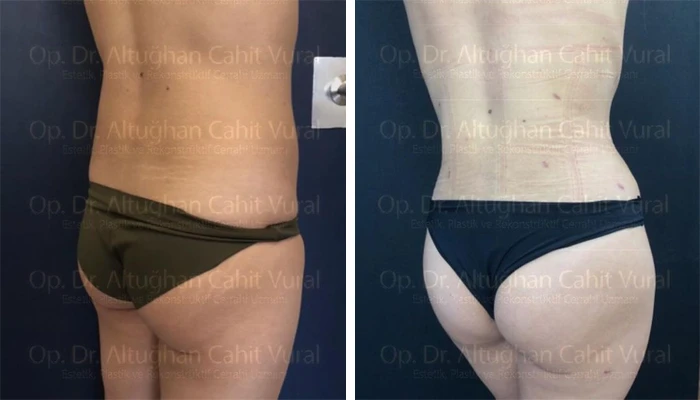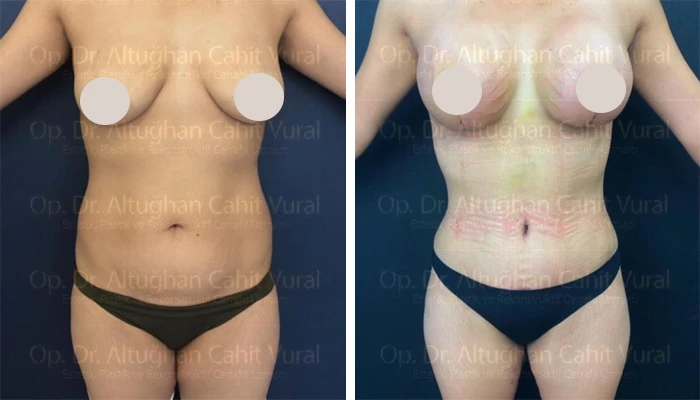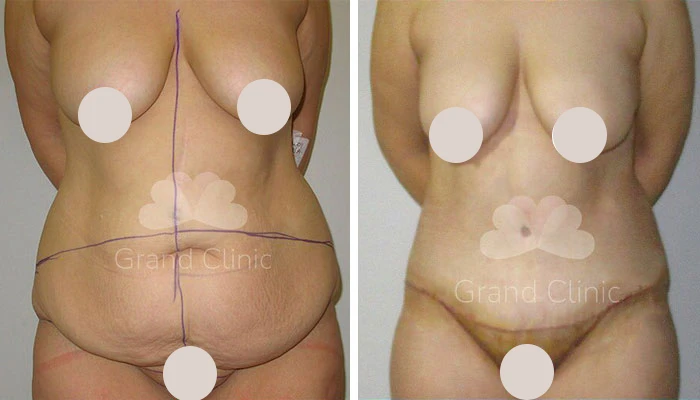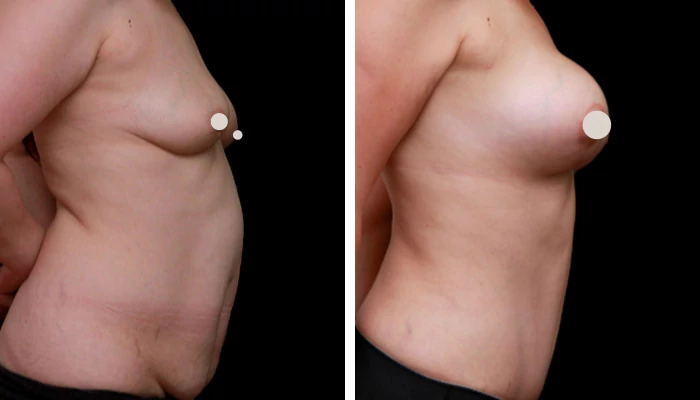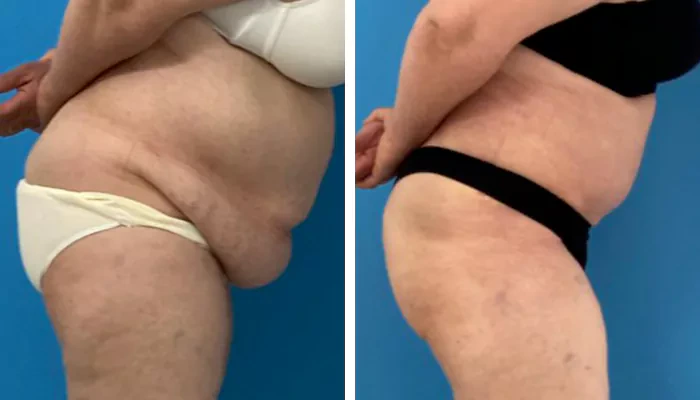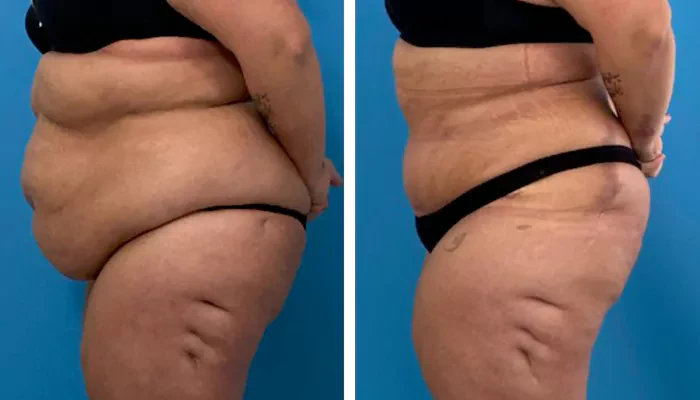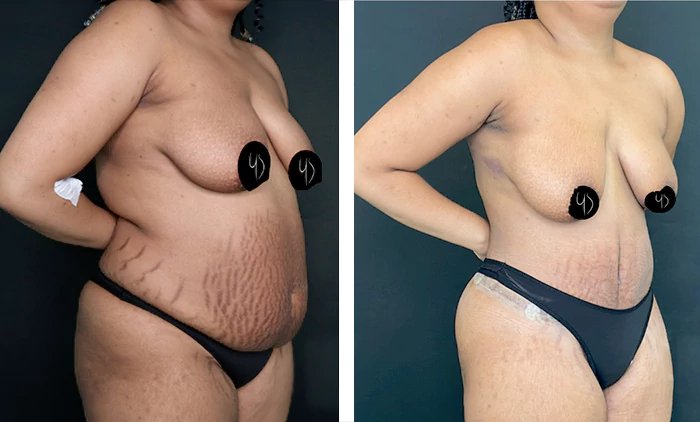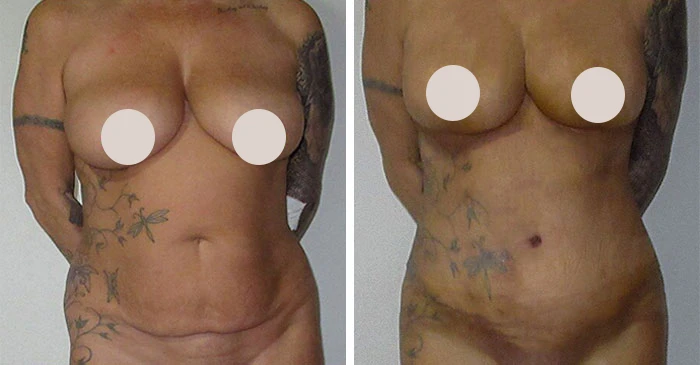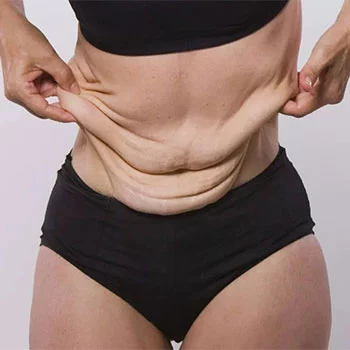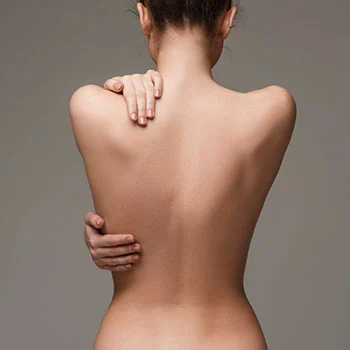What is a tummy tuck?
A tummy tuck, also known as abdominoplasty, is a surgical procedure aimed at improving the appearance of the abdomen by removing excess skin and fat, tightening the abdominal muscles, and contouring the midsection. This cosmetic surgery is commonly sought by individuals looking to address loose, sagging skin, weakened abdominal muscles, and stubborn fat deposits in the abdominal area.
During a tummy tuck, the surgeon makes incisions to remove excess skin and fat from the lower and middle abdomen. The abdominal muscles may be tightened to create a firmer abdominal profile. There are different types of tummy tucks, including a full tummy tuck (traditional abdominoplasty), mini tummy tuck (partial abdominoplasty), extended tummy tuck, and circumferential tummy tuck (body lift).
Why is a tummy tuck done?
A tummy tuck is performed for several reasons to address specific aesthetic concerns and improve the appearance of the abdomen. Here are some common reasons why individuals choose to undergo an abdominoplasty:
- Excess skin removal: One of the primary reasons for a tummy tuck is to remove excess, loose, or sagging skin in the abdominal area. This excess skin may result from factors such as significant weight loss, pregnancy, or aging, and can create a hanging or bulging appearance that is difficult to address with diet and exercise alone.
- Muscle tightening: A tummy tuck can tighten and repair weakened or separated abdominal muscles, a condition known as diastasis recti. This muscle laxity often occurs after pregnancy or significant weight fluctuations and can lead to a protruding abdomen or a "belly pooch."
- Contouring and shaping: Abdominoplasty can help contour and reshape the abdomen, creating a flatter, firmer, and more toned midsection. By removing excess skin and fat deposits, the procedure can enhance abdominal definition and improve overall body proportions.
- Enhancing body confidence: For many individuals, a tummy tuck can boost self-esteem and body confidence by addressing aesthetic concerns related to the abdomen. Achieving a more sculpted and youthful abdominal appearance can have a positive impact on self-image and quality of life.
- Post-pregnancy restoration: Women who have undergone pregnancy and childbirth may experience changes in their abdominal appearance, including stretched skin, weakened muscles, and stubborn fat deposits. A tummy tuck can help restore the pre-pregnancy contour of the abdomen and address postpartum changes.
- Weight loss transformation: Individuals who have achieved significant weight loss, whether through lifestyle changes, bariatric surgery, or other means, may be left with excess skin and tissue in the abdominal area. An abdominoplasty can complement weight loss efforts by removing this excess skin and providing a more defined body shape.
- Clothing fit and comfort: Removing excess abdominal skin and fat through a tummy tuck can improve the fit of clothing, allowing individuals to wear more form-fitting attire comfortably and confidently.
Overall, a tummy tuck is a popular cosmetic procedure that can address a range of aesthetic concerns related to the abdomen, helping individuals achieve a firmer, more sculpted midsection and enhancing their overall body contours.
Types of tummy tuck
There are several types of tummy tuck each tailored to address specific concerns and achieve desired aesthetic outcomes. Here are the main types of abdominoplasty:
- Traditional or full tummy tuck (full abdominoplasty): This is the most common type of tummy tuck procedure. It involves making a horizontal incision above the pubic area that extends between the hip bones. Excess skin and fat are removed, and the abdominal muscles are tightened. The belly button may be repositioned for a more natural appearance.
- Mini tummy tuck (mini abdominoplasty): Also known as a partial abdominoplasty, this procedure is suitable for individuals with less extensive abdominal concerns, typically limited to the area below the navel. A smaller incision is made, and excess skin is removed. Muscle tightening may be performed but to a lesser extent compared to a full tummy tuck.
- Extended abdominoplasty (extended tummy tuck): This procedure is recommended for individuals with significant excess skin and fat in the lower abdomen and around the hips and lower back area. The incision is longer, extending around the hips to address excess skin and tissue in the extended abdominal region.
- Circumferential abdominoplasty (belt lipectomy): This comprehensive procedure is often performed on individuals who have undergone massive weight loss and have excess skin circumferentially around the abdomen, back, and sides. The incision extends around the entire torso to remove excess skin and contour the midsection.
- Fleur-de-lis abdominoplasty (fleur-de-li tummy tuck): This type of tummy tuck is suitable for individuals with significant excess skin and tissue in the vertical as well as horizontal directions. It involves a vertical incision in addition to the horizontal incision made in a traditional abdominoplasty, resulting in a shape resembling a fleur-de-lis.
- Reverse tummy tuck (reverse abdominoplasty): In this less common procedure, excess skin and fat are removed from the upper abdomen, typically above the navel. It is often performed in conjunction with breast surgery, such as breast lift or reduction, to address excess skin and tissue in the upper abdominal area.
- Floating abdominoplasty: Also known as a high lateral tension abdominoplasty, this technique focuses on tightening the abdominal muscles and skin while preserving the blood supply to the abdominal tissue. It can create a smoother, more natural-looking abdominal contour with reduced risk of complications like tissue necrosis.
Each type of abdominoplasty is tailored to address specific concerns and achieve optimal results based on the individual's anatomy, aesthetic goals, and extent of correction needed. Consulting with a board-certified plastic surgeon specializing in body contouring procedures can help determine the most appropriate type of tummy tuck to achieve the desired abdominal contour and enhance overall body aesthetics.
Who is abdominoplasty suitable for?
Ideal candidates for a tummy tuck are individuals who meet the following criteria:
- Good overall health: Candidates for abdominoplasty should be in good general health, free from any medical conditions that could increase the risks of surgery or affect healing.
- Stable weight: Ideal candidates should be at or close to their target weight and have maintained a stable weight for a significant period. A tummy tuck is not a weight loss procedure but is intended to address excess skin, fat, and muscle laxity in the abdominal area.
- Realistic expectations: Individuals considering a tummy tuck should have realistic expectations about the outcomes of the procedure. While a tummy tuck can improve abdominal contour and tighten the midsection, it is important to understand the limitations of the surgery.
- Excess abdominal skin: Candidates with excess skin in the abdominal area, often due to factors like pregnancy, weight fluctuations, or aging, may benefit from a tummy tuck to remove the loose, sagging skin and achieve a firmer abdominal profile.
- Weakened abdominal muscles: Women who have experienced pregnancy or individuals with weakened abdominal muscles due to factors like weight gain or aging may benefit from a tummy tuck to tighten the abdominal muscles and restore core strength.
- Non-smokers: Smoking can increase the risks of complications during and after surgery, affecting healing and outcomes. Candidates for a tummy tuck are typically required to quit smoking before the procedure and throughout the recovery period.
- Commitment to recovery: Patients considering a tummy tuck should be willing to follow postoperative care instructions provided by their surgeon, including wearing compression garments, attending follow-up appointments, managing discomfort with prescribed medications, and gradually resuming normal activities as advised.
- Specific concerns: Individuals with specific concerns related to excess abdominal skin, fat deposits, or muscle laxity that have not improved with diet and exercise may be good candidates for a tummy tuck to address these aesthetic issues.
It is essential to consult with a board-certified plastic surgeon specializing in body contouring procedures to determine if a tummy tuck is suitable for your individual needs and goals. The surgeon can assess your candidacy, discuss the potential benefits and risks of the procedure, and create a personalized treatment plan to help you achieve the desired abdominal contour and improve your overall body aesthetics.
How to prepare for the procedure
Preparing for a tummy tuck procedure involves several steps to ensure a smooth surgery, optimal recovery, and satisfactory results. Here are some essential tips on how to prepare for abdominoplasty:
- Consultation: Schedule a consultation with a board-certified plastic surgeon specializing in body contouring procedures to discuss your goals, medical history, expectations, and the details of the tummy tuck procedure. Use this opportunity to ask questions, address concerns, and understand the preoperative and postoperative instructions.
- Medical evaluation: Undergo a comprehensive medical evaluation, including physical examinations, lab tests, and possibly additional screenings as recommended by your surgeon. Ensure that you are in good overall health and provide accurate information about your medical history, medications, allergies, and previous surgeries.
- Quit smoking: If you smoke, it is crucial to quit smoking several weeks before the tummy tuck procedure. Smoking can impair healing, increase the risks of complications, and negatively impact surgical outcomes. Your surgeon may require you to refrain from smoking for a specific period before and after surgery.
- Medications and supplements: Follow your surgeon's instructions regarding medications and supplements. You may be advised to avoid certain medications, such as blood thinners, herbal supplements, and anti-inflammatory drugs that can increase the risk of bleeding or interfere with anesthesia. Inform your surgeon about all medications you are taking.
- Healthy lifestyle: Maintain a healthy lifestyle by eating a balanced diet, staying hydrated, and engaging in regular exercise to optimize your overall health and support the healing process. Adequate nutrition and hydration can promote faster recovery and better surgical outcomes.
- Arrange for help: Plan for assistance during the initial days following the tummy tuck procedure, as you may need help with daily activities, transportation, and household tasks while recovering. Arrange for a responsible adult to accompany you on the day of surgery and stay with you during the first 24 hours postoperatively.
- Prepare your recovery space: Set up a comfortable recovery space at home with essential items within reach, such as loose and comfortable clothing, prescribed medications, pillows for support, and entertainment to keep you occupied during the initial recovery period.
- Follow preoperative instructions: Adhere to specific preoperative instructions provided by your surgeon, which may include guidelines on fasting before surgery, showering with antibacterial soap, avoiding alcohol consumption, and arranging for transportation to and from the surgical facility on the day of the procedure
By following these preparation tips and working closely with your plastic surgeon, you can help ensure a successful tummy tuck procedure, reduce the risks of complications, and promote a smoother recovery process with optimal results. It is important to communicate openly with your surgical team, address any concerns, and follow postoperative care instructions diligently to achieve the desired aesthetic outcomes.
What to expect during the surgery
During an abdominoplasty, several key steps are typically involved to address excess skin, fat, and muscle laxity in the abdominal area and achieve a firmer, more toned midsection. Here is an overview of what to expect during a tummy tuck procedure:
- Anesthesia: The surgery begins with the administration of anesthesia to ensure your comfort and safety throughout the procedure. Your surgeon will discuss the type of anesthesia used, which may include general anesthesia or intravenous sedation, based on your individual needs and the extent of the surgery.
- Incision: The surgeon will make incisions in strategic locations to access the abdominal tissues. The type and length of the incisions depend on the specific abdominoplasty technique being performed, such as a traditional, mini, extended, or circumferential abdominoplasty.
- Skin and fat removal: Excess skin and fat in the abdominal area are carefully removed through the incisions. The surgeon will trim and reshape the abdominal tissues to create a smoother, firmer contour and eliminate sagging or bulging skin.
- Muscle repair: If necessary, the surgeon will repair and tighten the weakened or separated abdominal muscles, a common issue following pregnancy or significant weight fluctuations. This muscle-tightening step helps restore core strength and improve abdominal tone.
- Repositioning the belly button: In a traditional tummy tuck, the belly button may be repositioned to create a more natural appearance as excess skin is removed and the abdominal tissues are reshaped. The belly button remains connected to its blood supply during this process.
- Closure: Once the desired corrections have been made, the incisions are meticulously closed with sutures to support the underlying tissues and promote proper healing. Surgical drains may be placed to prevent fluid buildup and aid in the healing process.
- Postoperative care: Following the surgery, you will be monitored in a recovery area as you awaken from anesthesia. Your surgical team will provide instructions on postoperative care, including how to manage discomfort, care for incisions, wear compression garments, and follow up with your surgeon for follow-up appointments.
- Monitoring: You will be monitored in a recovery area as you wake up from anesthesia, and your vital signs will be checked regularly.
A tummy tuck surgery is typically performed in an accredited surgical facility, such as a hospital, surgical center, or a surgeon's office equipped with the necessary operating room facilities. The procedure is carried out by a board-certified plastic surgeon or a qualified cosmetic surgeon with specialized training and experience in body contouring surgeries. Before undergoing a tummy tuck, patients should ensure that the surgical facility meets safety standards, the surgical team is skilled and experienced, and the surgeon has a proven track record of successful abdominoplasty procedures. It is essential to choose a reputable and qualified healthcare provider to perform the surgery to achieve optimal results and minimize potential risks.
Recovery and aftercare
The recovery and aftercare following a tummy tuck surgery are crucial aspects of the healing process that can impact the results and overall satisfaction with the procedure. Here are some key points to consider regarding recovery and aftercare following abdominoplasty:
- Pain management: Your surgeon will prescribe pain medications to manage discomfort during the initial recovery period.
- Compression garments: You may be instructed to wear compression garments to minimize swelling, support the abdominal tissues, and optimize healing.
- Drains: Surgical drains may be placed to remove excess fluid buildup from the surgical site. Your surgeon will provide instructions on drain care and removal.
- Rest and recovery: Plan to rest at home for the first few days following surgery, avoiding strenuous activities and lifting heavy objects.
- Activity restrictions: Follow your surgeon's guidelines on activity restrictions, such as avoiding bending, twisting, or engaging in vigorous exercise until cleared to do so.
- Healthy diet: Maintain a nutritious diet, stay hydrated, and avoid foods that may cause bloating or constipation, which can affect your comfort during recovery.
- Hygiene and wound care: Follow proper wound care instructions provided by your surgeon, including how to clean incisions, change dressings, and monitor for signs of infection.
- Scheduled visits: Attend follow-up appointments with your surgeon as scheduled to monitor your healing progress, remove sutures or drains, and assess your results.
- Postoperative instructions: Follow your surgeon's postoperative care instructions diligently, including when to resume normal activities, wear compression garments, and apply scar treatments.
- Scar management: Your surgeon may recommend scar treatments, such as silicone gel or sheets, to help minimize the appearance of scars over time.
- Maintain a healthy lifestyle: Continue to follow a healthy diet, exercise regimen, and lifestyle habits to support long-term results and overall well-being.
- Monitor results: Keep track of your healing progress and communicate any concerns or changes in your abdominal appearance with your surgeon.
By following these recovery and aftercare guidelines, communicating with your surgical team, and adhering to postoperative instructions, you can support a smooth recovery process, optimize your tummy tuck results, and promote long-term satisfaction with your abdominal contour. If you have any concerns or questions during your recovery, do not hesitate to reach out to your surgeon for guidance and support.
Potential risks and complications of abdominoplasty
A tummy tuck, like any surgical procedure, carries potential risks and complications, although they are relatively rare when performed by a qualified and experienced plastic surgeon in an accredited facility. It is essential to be aware of these risks before undergoing a tummy tuck surgery. Here are some potential risks and complications associated with abdominoplasty:
- Infection: While uncommon, there is a risk of developing an infection at the surgical site. Proper wound care, antibiotic prophylaxis, and sterile surgical techniques help minimize this risk.
- Bleeding: Excessive bleeding during or after surgery can occur, leading to hematoma formation. Your surgeon may use drains to prevent fluid accumulation and monitor for signs of bleeding.
- Poor wound healing: In some cases, the incisions may heal poorly, leading to delayed wound healing, wound separation, or skin necrosis. Following postoperative care instructions and avoiding smoking can help reduce this risk.
- Seroma: Seroma is the accumulation of fluid under the skin, which can cause swelling and discomfort. Drains are often used to prevent seroma formation, but it may still occur in some cases.
- Changes in sensation: Temporary or permanent changes in sensation, such as numbness, hypersensitivity, or altered nerve function, may occur in the abdominal area or around the incision sites.
- Scarring: All surgical procedures result in some degree of scarring. While efforts are made to minimize scarring and place incisions strategically, individual healing responses can vary, leading to visible scars. Proper scar care and treatments can help improve the appearance of scars over time.
- Asymmetry: Despite meticulous surgical techniques, there is a risk of asymmetry in the abdominal contour, belly button position, or skin laxity. Additional procedures may be necessary to address significant asymmetry.
- Blood clots: Deep vein thrombosis (DVT) and pulmonary embolism are rare but serious complications that can result from blood clots forming in the legs and traveling to the lungs. Early ambulation, compression stockings, and blood-thinning medications may be used to reduce this risk.
- Anesthesia risks: General anesthesia carries inherent risks, including allergic reactions, respiratory complications, and adverse reactions to anesthetic medications. Your anesthesiologist will closely monitor you during surgery to mitigate these risks.
- Unsatisfactory results: While abdominoplasty can achieve significant improvements in abdominal contour and muscle tone, individual results may vary. Unrealistic expectations or dissatisfaction with the aesthetic outcomes can occur in some cases.
It is essential to discuss these potential risks and complications with your plastic surgeon during the consultation process. By choosing a board-certified plastic surgeon, following preoperative and postoperative instructions diligently, and maintaining open communication with your surgical team, you can help minimize the risks and increase the likelihood of a successful tummy tuck surgery with satisfactory results.
Tummy tuck cost
The cost of a tummy tuck or abdominoplasty can vary depending on several factors, including the geographic location, the surgeon's experience and reputation, the complexity of the procedure, the surgical facility, and any additional fees associated with anesthesia, postoperative care, and follow-up visits. Here are some key points to consider regarding the cost of a tummy tuck:
- Average cost: In the United States, the average cost of a tummy tuck typically ranges from $5,000 to $12,000 or more. This cost may or may not include fees for the surgical facility, anesthesia, medical tests, postoperative garments, and follow-up appointments.
- Surgeon's fee: The surgeon's fee is a significant component of the total cost and reflects the expertise, training, and reputation of the plastic surgeon performing the tummy tuck. Board-certified plastic surgeons with extensive experience may charge higher fees.
- Facility fees: The cost of using a surgical facility, such as a hospital or an accredited surgical center, is typically included in the total cost of a tummy tuck. Facilities that meet stringent safety standards may incur higher fees.
- Anesthesia fees: Anesthesia fees cover the cost of administering anesthesia during the tummy tuck procedure. The type of anesthesia used and the length of the surgery can influence these fees.
- Additional costs: Additional costs may include preoperative medical tests, prescription medications, compression garments, surgical drains, postoperative care, and follow-up visits. It is essential to inquire about all potential costs associated with the procedure.
- Insurance coverage: In most cases, tummy tuck surgery is considered a cosmetic procedure and is not covered by insurance. However, if the procedure is performed for medical reasons, such as addressing excess skin after significant weight loss or repairing abdominal muscles weakened by pregnancy, insurance coverage may be possible. It is advisable to check with your insurance provider regarding coverage eligibility.
- Financing options: Some plastic surgery practices offer financing plans or payment options to help patients manage the cost of a tummy tuck.
When considering the cost of an abdominoplasty procedure, it is essential to prioritize the quality and safety of the procedure over price alone. Choosing a board-certified plastic surgeon with a proven track record of successful tummy tuck surgeries and a reputable surgical facility can help ensure a positive surgical experience and optimal results.
Abdominoplasty alternatives
While a tummy tuck is a popular surgical procedure to address excess skin, fat, and muscle laxity in the abdominal area, there are non-surgical and minimally invasive alternatives that may be considered for individuals seeking to improve their abdominal contour without undergoing surgery. Here are some alternatives to abdominoplasty:
- Panniculectomy: A panniculectomy is a surgical procedure that focuses on removing excess skin and tissue from the lower abdomen, specifically addressing the pannus or apron of skin that hangs over the pubic area. While similar to a tummy tuck (abdominoplasty) in some aspects, panniculectomy is primarily performed to alleviate medical issues caused by the overhanging skin rather than for cosmetic reasons.
- Liposuction: Liposuction is a minimally invasive procedure that targets stubborn fat deposits in specific areas of the body, including the abdomen. While liposuction does not address excess skin or muscle laxity, it can help sculpt and contour the abdomen by removing localized fat pockets. Liposuction is often combined with other non-surgical treatments for optimal results.
- CoolSculpting: CoolSculpting, also known as cryolipolysis, is a non-invasive fat reduction treatment that freezes and eliminates fat cells through controlled cooling. CoolSculpting is suitable for reducing small amounts of fat in the abdomen and other areas without surgery. Multiple treatment sessions may be required to achieve desired results.
- Radiofrequency skin tightening: Radiofrequency (RF) skin tightening treatments use energy waves to heat the skin and stimulate collagen production, resulting in tighter, firmer skin. RF treatments can improve skin laxity in the abdominal area and enhance overall skin tone without surgery. Multiple sessions may be needed for optimal results.
- Ultrasound therapy: Ultrasound therapy, such as Ultherapy, delivers focused ultrasound energy to target deep layers of skin and stimulate collagen production. Ultrasound treatments can improve skin laxity and firmness in the abdomen, offering a non-surgical alternative to abdominoplasty.
- Body contouring treatments: Non-surgical body contouring treatments, such as SculpSure, truSculpt, or Venus Legacy, use various technologies to reduce fat, tighten skin, and improve body shape without surgery. These treatments can be customized to target specific areas of concern, including the abdomen.
- Diet and exercise: A healthy diet and regular exercise regimen play a crucial role in maintaining a toned and sculpted abdomen. By adopting a balanced diet, staying hydrated, and engaging in targeted abdominal exercises, individuals can improve muscle tone, reduce body fat, and enhance overall body composition.
- Compression garments and shapewear: Compression garments and shapewear can provide temporary contouring effects by smoothing and shaping the abdomen. These garments offer support, enhance body confidence, and can be worn daily for a streamlined appearance.
It is important to consult with a board-certified plastic surgeon or qualified aesthetic provider to discuss your aesthetic goals, assess your individual needs, and determine the most suitable treatment options for achieving desired results. While non-surgical alternatives to abdominoplasty can offer benefits such as minimal downtime, less invasive procedures, and gradual improvements, they may have limitations in addressing certain concerns related to excess skin or muscle separation that are best addressed through surgical intervention.
Abdominoplasty vs panniculectomy
Abdominoplasty and panniculectomy are both surgical procedures that focus on addressing excess skin and tissue in the abdominal area, but they serve distinct purposes and are recommended for different patient populations based on their individual needs and goals. Here are the key differences between a tummy tuck and a panniculectomy:
Purpose
Abdominoplasty is a cosmetic surgical procedure aimed at improving the appearance of the abdomen by addressing excess skin, fat, and muscle laxity. It is commonly performed to achieve a flatter abdomen, narrower waistline, and improved abdominal contour.
Panniculectomy is a functional surgical procedure intended to remove the pannus or overhanging apron of skin in the lower abdomen that can cause medical issues such as skin irritation, infections, hygiene problems, and mobility limitations.
Medical necessity
Abdominoplasty is typically considered an elective cosmetic procedure and is not usually performed for medical reasons unless there are specific functional concerns that can be addressed concurrently.
Panniculectomy is often deemed medically necessary when the excess skin in the lower abdomen causes significant physical discomfort or health issues that impact the patient's quality of life.
Extent of surgery
Abdominoplasty involves not only the removal of excess skin and tissue but also muscle repair and tightening of the abdominal muscles, especially in cases of muscle separation (diastasis recti) commonly seen after pregnancy or significant weight fluctuations.
Panniculectomy primarily focuses on excising the overhanging skin and tissue in the lower abdominal area, with less emphasis on muscle repair or cosmetic contouring of the abdomen.
Cosmetic vs functional concerns
Abdominoplasty is primarily performed to address cosmetic concerns and achieve aesthetic improvements in the abdominal appearance, such as a flatter, more toned abdomen and reduced skin laxity.
Panniculectomy targets functional issues related to excess skin, aiming to alleviate physical discomfort, skin irritation, infections, and mobility challenges caused by the overhanging pannus.
Insurance coverage
Abdominoplasty is typically considered a cosmetic procedure and is not covered by health insurance, as it is elective and performed for aesthetic reasons.
Panniculectomy may be covered by health insurance in cases of medical necessity, where the excess skin causes documented health problems that impact the patient's well-being and functionality.
FAQs
Can abdominoplasty get rid of stretch marks?
Abdominoplasty can improve the appearance of stretch marks located on the lower abdomen by removing the skin below the belly button. However, it may not eliminate all stretch marks, especially those outside the excised skin area.
How long does a tummy tuck surgery take?
The duration of a tummy tuck surgery typically ranges from 2 to 5 hours, depending on the extent of the procedure, whether muscle repair is included, and if additional treatments like liposuction are performed concurrently.
Will I get visible scars after a tummy tuck?
While scarring is inevitable after a tummy tuck, a skilled surgeon will strategically place incisions within natural skin folds or areas covered by clothing for discreet scarring. Scars will fade over time but may remain visible.
Are abdominoplasty results permanent?
Abdominoplasty results can be long-lasting, especially when accompanied by a healthy lifestyle, including maintaining a stable weight and regular exercise. However, natural aging processes and significant weight fluctuations can impact the longevity of the results.

